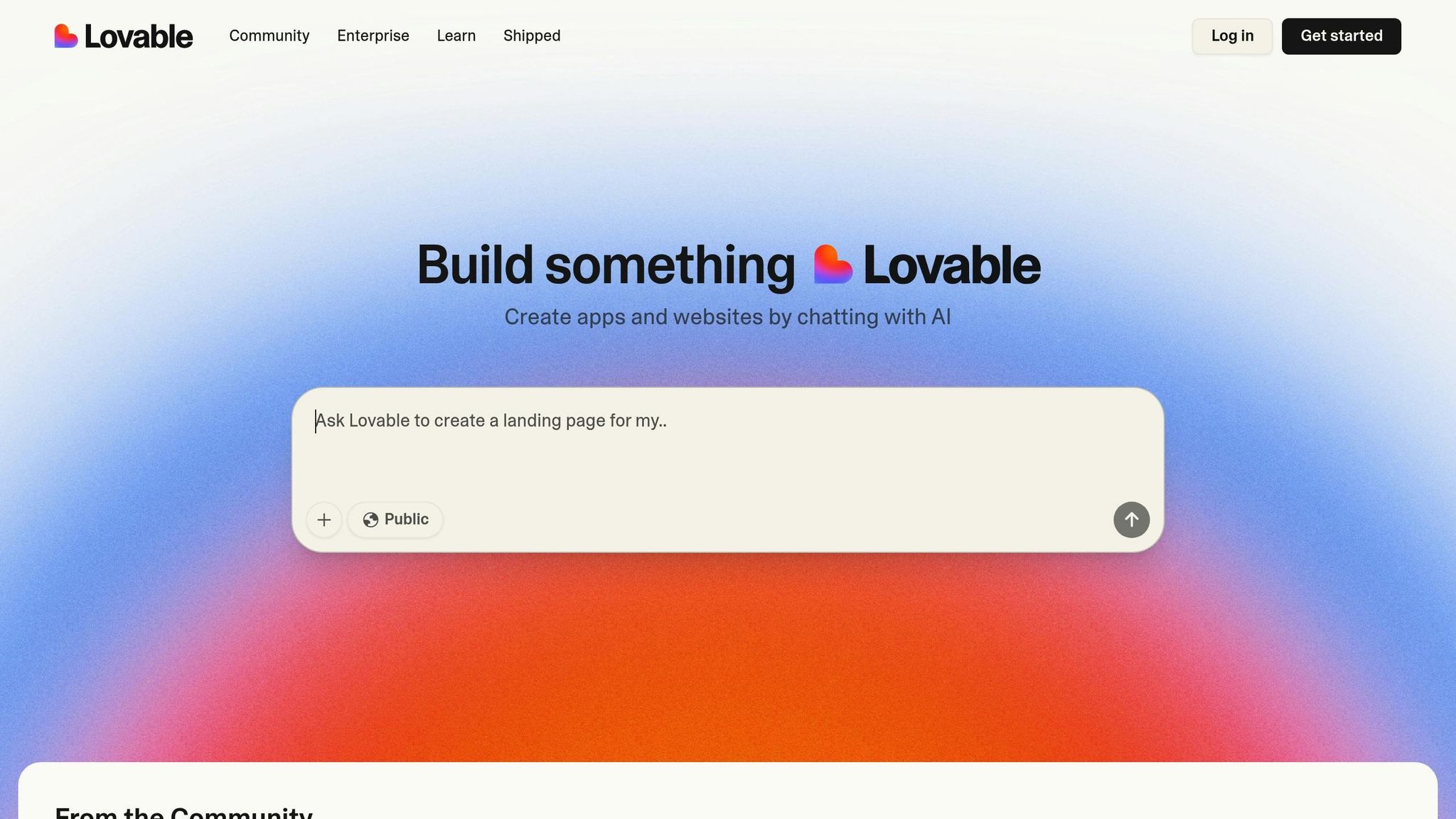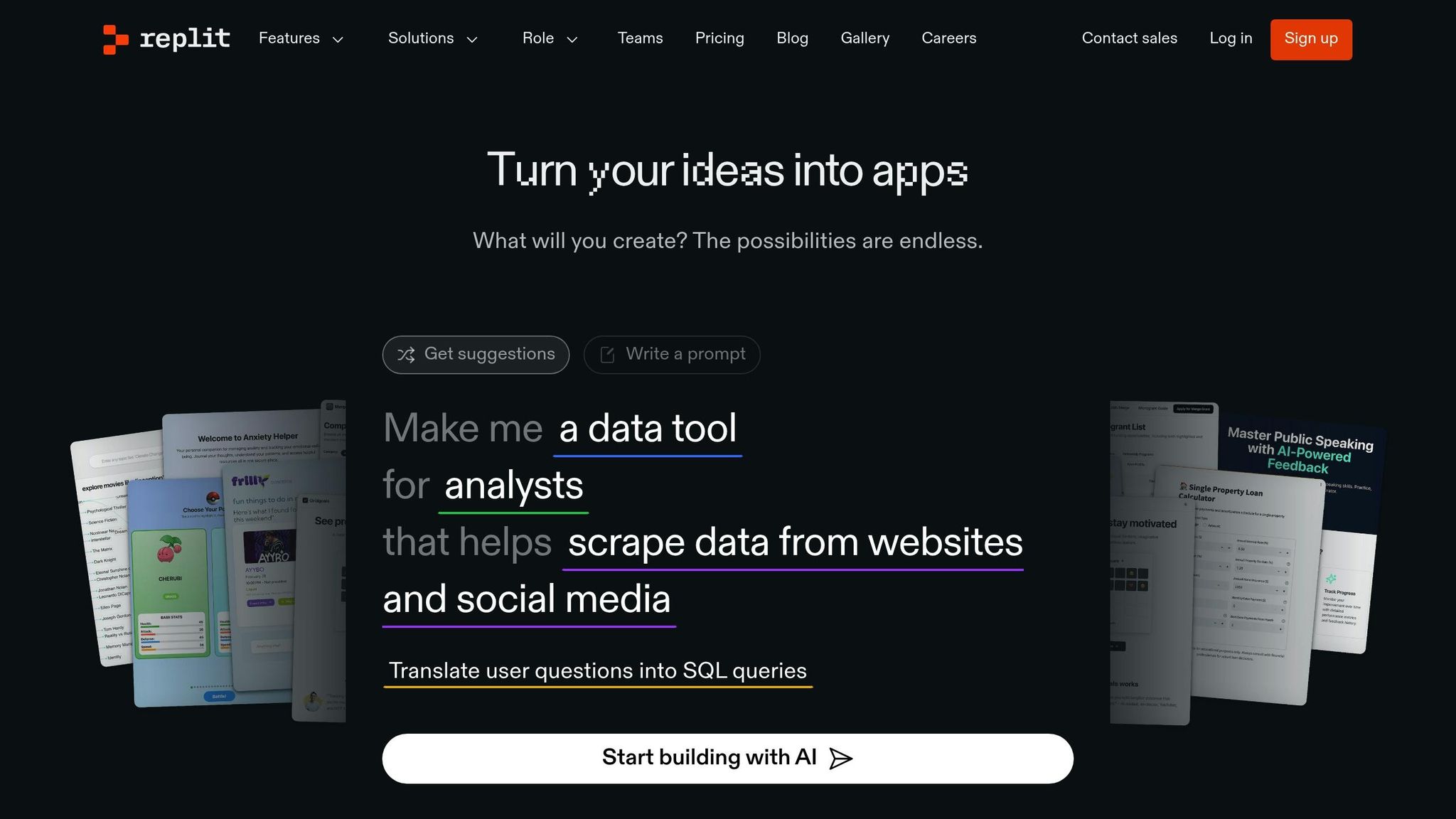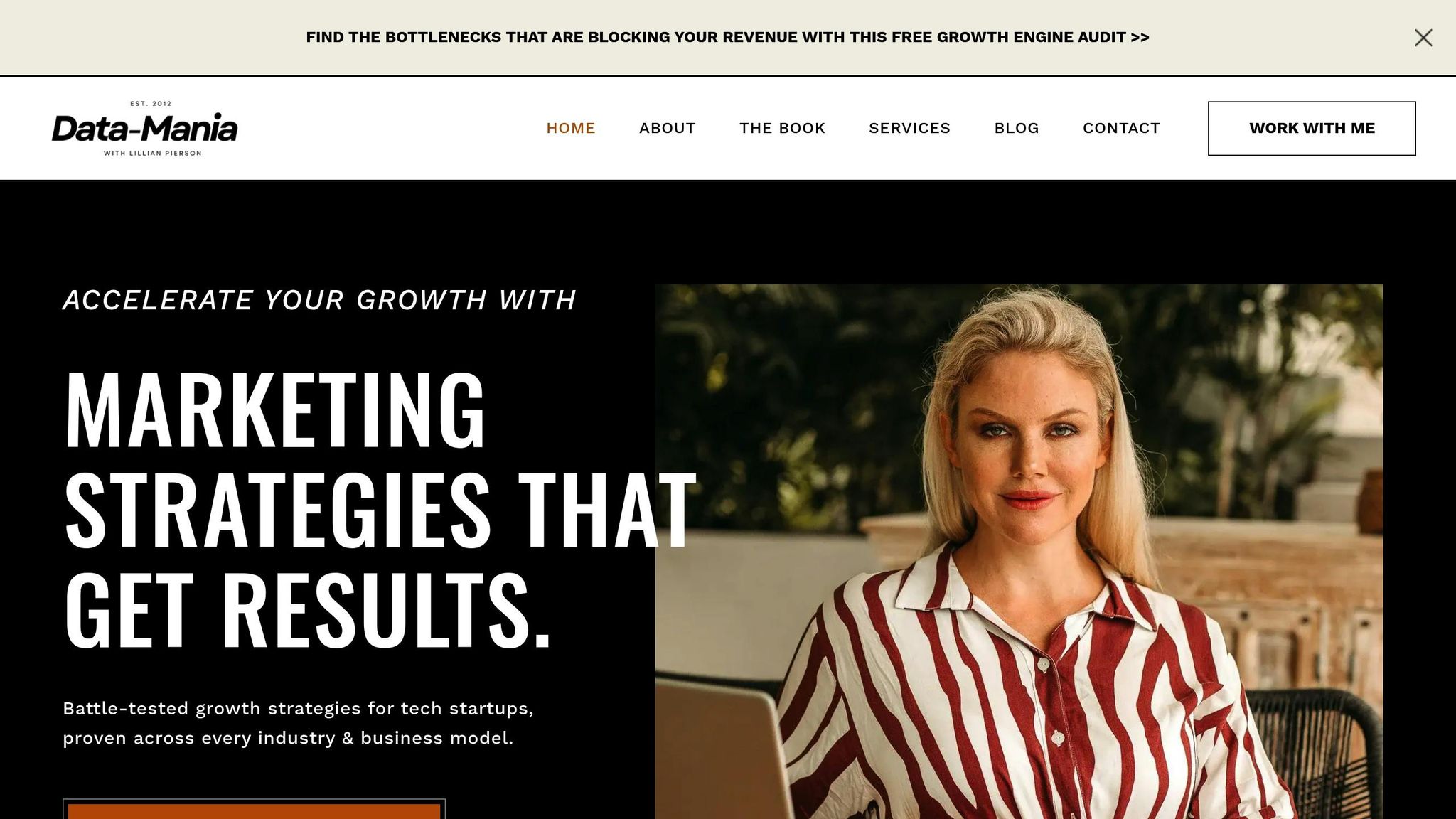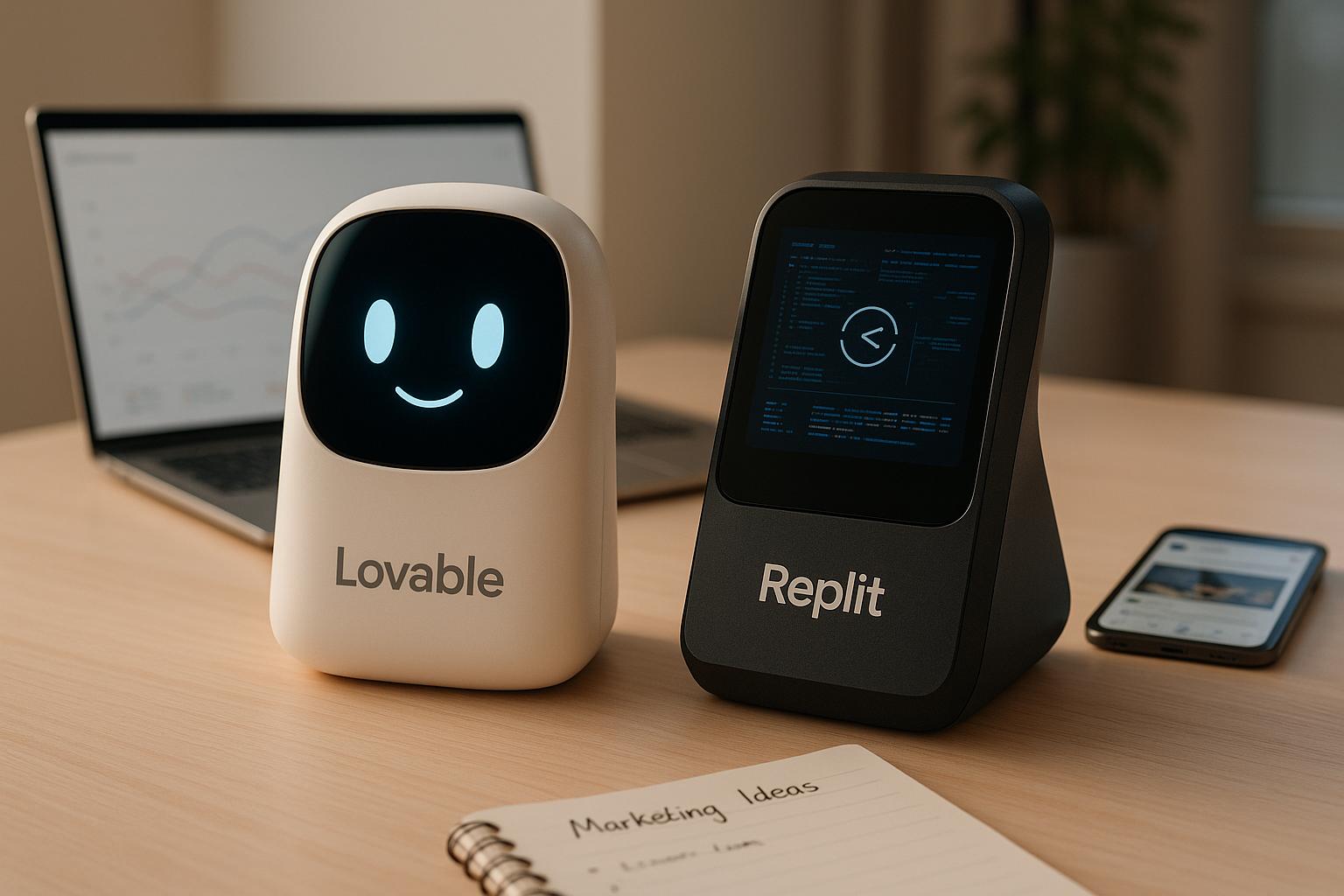Looking for the best AI assistant for marketing automation? Here’s a quick breakdown:
- Lovable: Perfect for non-technical marketers. It’s a no-code platform that lets you build marketing tools quickly and easily through a visual interface. Great for creating dashboards, automating simple workflows, and prototyping. Starts at $25/month.
- Replit: Best for tech-savvy users. It provides full coding control to build custom, complex automation tools. Ideal for advanced data analysis, backend logic, and tailored marketing solutions. Starts at $10/month.
Quick Comparison
| Feature | Lovable | Replit |
|---|---|---|
| Skill Level | No coding needed | Requires programming knowledge |
| Setup Time | Minutes to hours | Hours to days |
| Customization | Limited to visual interface | Full coding control |
| Backend Support | None | Full backend development |
| Best For | Simple workflows, quick results | Complex, custom solutions |
| Pricing | Starts at $25/month | Starts at $10/month |
Bottom Line: Choose Lovable for simplicity and speed, or Replit for flexibility and advanced customization. Both tools can transform your marketing automation – pick the one that fits your skills and goals.
Lovable for Marketing Automation

Lovable breaks down technical barriers, giving non-technical marketers the tools to create powerful AI-driven solutions. The platform’s impact is clear, with more than 500,000 founders already building with Lovable.
Lovable Key Features
Lovable’s no-code AI platform lets users design intelligent marketing tools through a simple, visual interface driven by prompts. Instead of needing technical expertise, marketers can describe features in plain language, and the platform transforms those descriptions into working applications.
One standout feature is the "Select & Edit" tool. This allows marketing teams to quickly refine their projects – whether it’s tweaking dashboards, updating lead capture forms, or modifying campaign tracking interfaces – by simply clicking on elements and describing the desired changes.
The platform also supports database integration and API connections, making it easy to link existing tools and data sources. Additionally, Lovable uses a prompt system that combines natural language, variables, and logic flows to create modular components. For example, once a lead qualification system is built, it can be adapted effortlessly for other campaigns or customer segments.
These capabilities make Lovable a flexible tool for various marketing needs.
Lovable Marketing Use Cases
Marketing teams leverage Lovable to create custom dashboards for tracking campaign performance and refining strategies. For instance, a mid-size SaaS company used Lovable to build an internal assistant that monitors its development pipeline. This assistant auto-generates summaries when builds fail, integrating with GitHub Actions and Slack to deliver clear, actionable insights. This kind of automation keeps teams informed about product updates without requiring advanced technical skills.
Lovable is also used to develop lead qualification systems and customer service automation tools. Teams can define their ideal customer profiles and criteria, and the platform generates the necessary logic. Additionally, marketers can create API-powered tools for market research, pulling live data from competitors, social media, or industry databases. These tools can automatically generate reports or trigger marketing actions based on real-time findings.
"I absolutely LOVE your product! It is the single best thing that I experienced since I found ChatGPT! The value that you create with this is just over the top mind-blowing as it basically replaces or enhances a ton of SaaS-Solutions in an instant." – Thomas
Lovable Limitations
While Lovable simplifies AI development, it does have its limitations. For marketing teams that need highly customized or complex workflows, the platform’s focus on simplicity can be a drawback. Intricate conditional logic or specialized integrations beyond standard API connections may be harder to implement.
Scaling can also present challenges. Larger teams often underutilize their marketing tech, and Lovable may lack the advanced user management features or workflow approval processes that enterprise-level organizations require.
Another concern is the risk of over-automation. The ease of building workflows could lead to interactions that feel impersonal or robotic if not carefully managed. Additionally, even though Lovable is a no-code platform, maintaining automation workflows still requires regular updates to keep up with changing customer needs and market trends.
"Lovable empowers me to create frontends that surpass my own technical limitations. It allows me to swiftly develop prototypes to showcase to clients, without the need for generic templates or starting from scratch." – Marius, Veloxforce
Replit for Marketing Automation

Replit is a cloud-based IDE equipped with AI capabilities, designed for tech-savvy marketers who want full control over crafting custom automation tools. It’s particularly suited for those with coding experience or a desire to learn. Unlike no-code platforms, Replit offers the freedom to build exactly what you need – whether it’s a detailed data pipeline, a custom analytics dashboard, or a complex email automation system.
Replit Key Features
Replit stands out thanks to its AI-powered development environment, which merges traditional coding with smart assistance. Over time, the platform has expanded its AI tools beyond the original Ghostwriter AI to include Replit Agent and Replit Assistant.
- Replit Agent: This feature translates natural language prompts into functional applications, automating up to 90% of the initial code. It’s a game-changer for speeding up tool development.
- Replit Assistant: Embedded directly in the coding environment, this tool offers real-time support, including code completion, debugging, explanations, and refactoring. It helps marketers write better code faster, even if they’re not professional developers.
"Ghostwriter sports an ML-powered pair programmer that completes your code in real time, tools to generate, transform, and explain code, and an in-editor search utility that lets you find and import open-source code without leaving your editor."
- Amjad Masad, Samip Dahal, Alexandre Cai, and Giuseppe Burtini
Replit supports over 50 programming languages and comes with built-in deployment tools. This means you can build, test, and launch marketing tools without needing separate services. Plus, Replit manages the backend infrastructure, taking care of server management and scaling. These features allow technical marketers to create tools tailored to their specific workflows and data needs.
Replit Marketing Use Cases
Replit’s flexibility enables marketers to create advanced, custom solutions that go beyond the capabilities of no-code platforms. Here’s how marketers are using it:
- Custom Data Scraping and Analysis: With Replit, marketers can develop scripts to monitor competitor pricing, track social media mentions, analyze market trends, and aggregate data from multiple sources. These tools can run continuously, delivering fresh insights directly to dashboards or triggering automated actions.
- Advanced Email Automation: Replit allows for the creation of systems that personalize messages using complex behavioral data, integrate seamlessly with CRMs, and adjust sending patterns based on engagement. This goes far beyond standard drip campaigns.
- Content Automation: Teams can build tools that generate topic ideas from trending keywords, create dynamic content calendars, and even draft initial blog posts using AI APIs integrated through custom code.
One standout example is OpenMoves, a digital marketing agency, which used Replit in February 2025 to build a Google Ads application. The tool visualized performance data by zip code, allowed users to upload client locations for comparison, and included customizable filters and metrics. The project cost just $30 in Replit tokens and took about 7 hours to complete (Source: OpenMoves – Digital Marketing Agency NY, 2025).
- Custom Analytics Dashboards: Marketers can integrate data from multiple platforms, apply tailored calculations, and create visualizations that standard analytics tools can’t match. This allows for unified dashboards with custom attribution models and predictive analytics.
Replit Limitations
While Replit offers unmatched flexibility, it’s not without its challenges. Here are the main drawbacks:
- Technical Skill Requirement: Replit demands a solid understanding of programming concepts, debugging, and software architecture. Even with AI assistance, marketers need coding expertise to create effective tools.
- Time Investment: Building custom solutions takes significantly longer than using pre-built tools. Even with Replit Agent automating much of the groundwork, development can delay campaign execution when speed is critical.
- Ongoing Maintenance: Unlike no-code platforms that handle updates automatically, Replit-built tools require regular maintenance. This includes adapting to API changes, addressing security updates, and meeting evolving business needs, which can be a burden without dedicated technical resources.
- Learning Curve: For marketers without a programming background, getting up to speed on Replit can be daunting. While AI tools are helpful, understanding project structure, debugging, and performance optimization still requires effort.
- Cost Management: Development expenses can add up quickly. Replit Agent costs $0.25 per checkpoint, and Advanced Assistant charges $0.05 per edit request. While Replit Core includes $25 in monthly credits and Teams offers $40 per user, heavy development can exceed these allowances.
"Replit is not a traditional media tool, but its potential for custom automation, rapid prototyping, and AI-enhanced coding makes it a unique enabler for modern marketing teams."
- Debashis Mohapatra, Replit, Inc.
Lovable vs Replit Comparison
Deciding between Lovable and Replit for marketing automation comes down to your technical expertise, the complexity of your project, and whether you prioritize speed or control. Lovable is tailored for non-technical users who want to quickly create prototypes using a visual drag-and-drop interface. On the other hand, Replit is designed for those comfortable with coding, offering extensive customization but requiring more time to set up. Below, the comparison table and summary break down the key differences to help marketers align their choice with specific project needs.
Feature Comparison Table
| Feature | Lovable | Replit |
|---|---|---|
| User Skill Level | No coding experience required | Programming knowledge needed |
| Setup Speed | Minutes to hours | Hours to days |
| AI Assistant | Prompt-based UI generator | Ghostwriter |
| Customization Depth | Limited, visual interface only | Full code control |
| Backend Support | None | Full backend development |
| Deployment | Requires manual export | Built-in deployment tools |
| Marketing Use Cases | Simple automation and UI prototypes | Comprehensive marketing solutions, including data analysis and email automation |
| Pricing | Starts at ~$25/month | Starts at ~$30/month (includes $25 credits) |
| Best For | Non-technical marketers and rapid MVPs | Technical marketers seeking custom solutions |
| Learning Curve | Minimal | Moderate to steep |
Beyond these features, the platforms differ in their scope and deployment capabilities. Replit functions as a robust in-browser IDE, enabling full-stack development, while Lovable focuses primarily on UI creation. However, Lovable requires manual export for deployment, whereas Replit includes built-in tools to launch applications directly from the platform and manage complex integrations.
For marketing automation, these differences are crucial. Replit is ideal for tasks like data analysis, backend logic, and email automation, while Lovable excels at creating simple dashboards and rapid UI prototypes.
Pricing reflects these distinctions. Lovable is more budget-friendly for quick MVPs, while Replit supports more complex projects that demand backend development and integration. Your choice ultimately depends on whether you need a fast, UI-focused solution or a platform capable of handling comprehensive system builds.
sbb-itb-e8c8399
Which Tool to Choose
Deciding between Lovable and Replit boils down to your technical expertise, the complexity of your project, and how quickly you need results. Both platforms are great for marketing automation, but they cater to different types of users.
Choose Lovable If
Lovable is perfect for marketers without coding skills who want to automate tasks quickly and efficiently. If you’re a solo entrepreneur, product manager, or marketing professional, Lovable’s user-friendly, design-first approach lets you create prototypes and see results in minutes. It’s especially handy for building marketing dashboards, landing pages, or simple automation tools for presentations or internal use. Impressively, Lovable achieved $4M in annual recurring revenue within just four weeks, highlighting how fast it can deliver results. Its interface automates about 80% of marketing tasks. However, some users have noted issues with incomplete builds or non-functional features, so thorough testing is crucial before full deployment. For projects requiring more customization, you might want to consider Replit.
Choose Replit If
Replit is a better fit for marketers who are comfortable with coding or are eager to learn. It’s designed for creating more complex and customized automation tools. If your project involves data-heavy tasks like customer segmentation, advanced email automation, or custom analytics, Replit’s integrated coding environment is up to the challenge. Tools like Replit’s Ghostwriter, an AI pair-programming assistant, can reduce routine coding tasks by as much as 55%, making it easier even for those with limited experience. Replit is ideal for projects that need robust backend functionality, database integration, or API connections. Keep in mind, though, that it has a steeper learning curve and may require an iterative development process.
Using These Tools with Data-Mania Services

Once you’ve chosen the right platform, integrating it with Data-Mania’s services can take your marketing automation to the next level. Both Lovable and Replit work seamlessly with Data-Mania’s fractional CMO offerings, which are designed to help tech companies craft effective go-to-market strategies using AI tools.
For Lovable users, Data-Mania pinpoints workflows that benefit from rapid prototyping and helps design efficient systems for AI startups, data platforms, and climate tech companies. For Replit users, Data-Mania’s expertise in technical marketing – driven by founder Lillian Pierson’s unique mix of marketing leadership and engineering knowledge – ensures smooth scaling and integration with your existing tech stack. No matter which tool you choose, Data-Mania’s services help align your marketing automation efforts with your business goals, setting clear KPIs and creating a strategy that maximizes your investment.
Conclusion
Deciding between Lovable and Replit for marketing automation depends on your technical expertise, the complexity of your project, and the resources you have on hand. Lovable is ideal for those seeking quick results through rapid UI prototyping and no-code solutions. On the other hand, Replit offers a full development environment with advanced backend capabilities, making it a better fit for building sophisticated automation tools.
When it comes to pricing, Replit starts at $10/month, catering to developers, while Lovable begins at $25/month, targeting design-focused users. Replit’s AI tools can streamline coding tasks by up to 55%, highlighting its efficiency for more technical users. These pricing differences reflect the unique strengths and focus of each platform.
To summarize their use cases: Lovable shines for rapid prototyping and ease of use, while Replit is better suited for those who need a customizable, developer-friendly environment. Research shows that marketers who define clear, measurable goals are nearly four times more likely to achieve success than those who don’t. Regardless of the platform you choose, setting specific objectives and tracking key performance indicators (KPIs) will be vital for achieving success in marketing automation.
If you’re comfortable working with code and need complex integrations, Replit’s robust capabilities will likely meet your needs. However, if you’d rather concentrate on marketing strategy and let the platform handle the technical aspects, Lovable’s no-code, user-friendly design can help you achieve results faster. Choose the platform that aligns with your workflow and goals to transform your approach to marketing automation.
FAQs
How do Lovable and Replit differ in terms of required skills and customization for marketing automation?
Lovable is a great choice for those who aren’t tech-savvy. It features a no-code interface that allows marketers and solopreneurs to create AI agents simply by using natural language prompts. This makes it perfect for tasks like quickly setting up marketing automations, building prototypes, or launching campaigns – all without needing to write a single line of code.
Replit, on the other hand, caters to users with technical expertise. As a cloud-based IDE equipped with Ghostwriter AI, it offers robust tools for coding and developing custom solutions. This makes it ideal for marketers who are comfortable with programming and want complete control over their automations and backend processes.
To sum it up: pick Lovable if you value ease and speed, and go with Replit if you need advanced customization and coding capabilities.
What backend and deployment options do Lovable and Replit offer for marketing automation?
Lovable streamlines backend integration by supporting databases and APIs, letting you connect your existing systems or opt for built-in solutions like Supabase. This feature makes it a strong choice for building AI-powered marketing automations without diving into technical hurdles.
Replit, in contrast, shines in flexible deployment, making it easy to host projects like marketing tools and automations. It also simplifies sharing and managing access, which is especially appealing to tech-savvy marketers aiming to deploy and oversee custom solutions efficiently.
While both platforms handle deployment, Lovable focuses on backend connectivity to power automation, whereas Replit stands out for hosting and sharing web-based tools.
Which platform, Lovable or Replit, is better for a small marketing team looking for affordable and fast automation?
For small marketing teams looking to automate tasks without spending a fortune, Replit often stands out as the more budget-friendly choice. With plans starting at just $15–$20 per month, it’s a solid option for marketers who have the technical know-how to build custom tools. On the other hand, Lovable comes in at $20–$50 per month but shines with its no-code interface, making it perfect for non-technical users or solopreneurs who value simplicity and ease of use over technical flexibility.
Go with Replit if you’re comfortable creating customized solutions with technical skills. Opt for Lovable if you prefer a straightforward, no-code platform that gets you up and running in no time.
Related Blog Posts
- 5 Ways AI Can Optimize Marketing ROI for your Tech Startup
- Top Vibe Coding Tools for Marketing: Automate Campaigns with AI Agents
- AI Tools for Product Marketing: What’s Worth Using (and What’s Not)
- AI Marketing Automation Is Taking Over: Here’s How to Stay Ahead of the Curve




